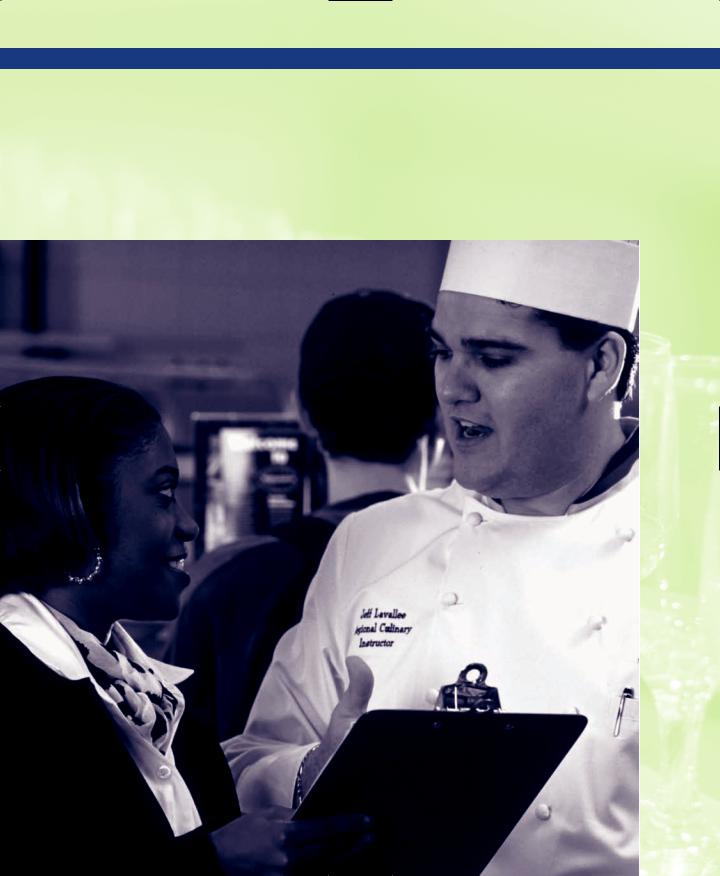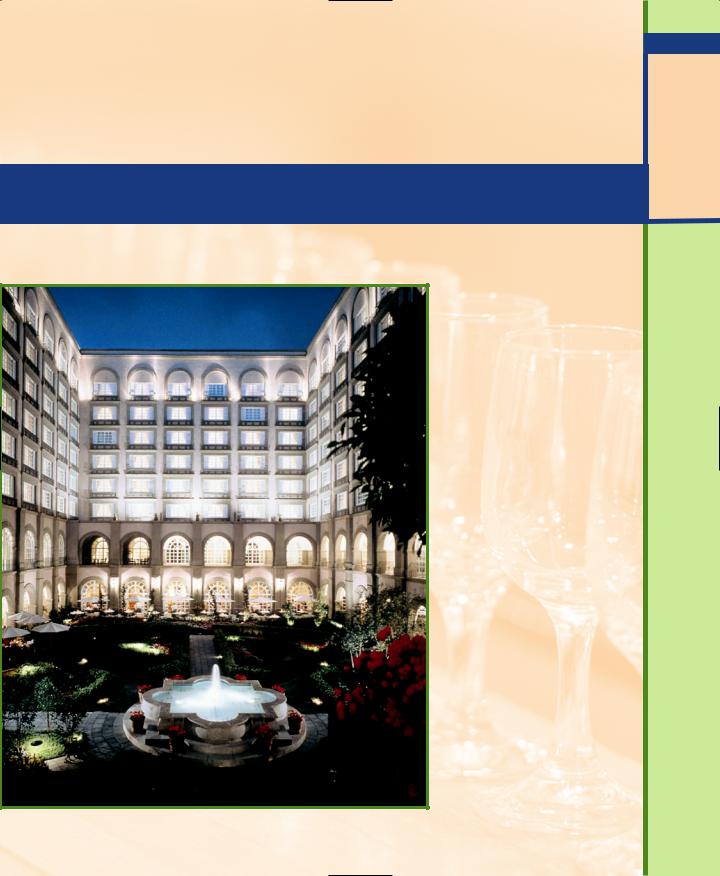
- •CONTENTS
- •PREFACE
- •Content—Benefits for Students
- •Content—Benefits for Instructors
- •Features of the Book for Students and Instructors
- •Supplementary Materials
- •Acknowledgments
- •What Is Hospitality Management?
- •The Manager’s Role in the Hospitality Industry
- •Why Study in a Hospitality Management Program?
- •Planning a Career
- •Employment as an Important Part of Your Education
- •Getting a Job
- •Employment at Graduation
- •The Outlook for Hospitality
- •Summary
- •Managing Change
- •Demand
- •Supply
- •Workforce Diversity
- •The Impact of Labor Scarcity
- •Summary
- •The Varied Field of Food Service
- •The Restaurant Business
- •The Dining Market and the Eating Market
- •Contemporary Popular-Priced Restaurants
- •Restaurants as Part of a Larger Business
- •Summary
- •Restaurant Operations
- •Making a Profit in Food Service Operations
- •Life in the Restaurant Business
- •Summary
- •Chain Restaurant Systems
- •Independent Restaurants
- •Franchised Restaurants
- •Summary
- •Competitive Conditions in Food Service
- •The Marketing Mix
- •Competition with Other Industries
- •Summary
- •Self-Operated Facilities
- •Managed-Services Companies
- •Business and Industry Food Service
- •College and University Food Service
- •Health Care Food Service
- •School and Community Food Service
- •Other Segments
- •Vending
- •Summary
- •Consumer Concerns
- •Food Service and the Environment
- •Technology
- •Summary
- •The Evolution of Lodging
- •Classifications of Hotel Properties
- •Types of Travelers
- •Anticipating Guest Needs in Providing Hospitality Service
- •Service, Service, Service
- •Summary
- •Major Functional Departments
- •The Rooms Side of the House
- •Hotel Food and Beverage Operations
- •Staff and Support Departments
- •Income and Expense Patterns and Control
- •Entry Ports and Careers
- •Summary
- •The Economics of the Hotel Business
- •Dimensions of the Hotel Investment Decision
- •Summary
- •The Conditions of Competition
- •The Marketing Mix in Lodging
- •Product in a Segmented Market
- •Price and Pricing Tactics
- •Place—and Places
- •Promotion: Marketing Communication
- •Summary
- •The Importance of Tourism
- •Travel Trends
- •The Economic Significance of Tourism
- •The United States as an International Tourist Attraction
- •Businesses Serving the Traveler
- •Noneconomic Effects of Tourism
- •Summary
- •Motives and Destinations
- •Mass-Market Tourism
- •Planned Play Environments
- •Casinos and Gaming
- •Urban Entertainment Centers
- •Temporary Attractions: Fairs and Festivals
- •Natural Environments
- •On a Lighter Note. . .
- •Summary
- •Management and Supervision
- •The Economizing Society
- •The Managerial Revolution
- •Management: A Dynamic Force in a Changing Industry
- •What Is Management?
- •Summary
- •Why Study Planning?
- •Planning in Organizations
- •Goal Setting
- •Planning in Operations
- •The Individual Worker as Planner
- •Long-Range Planning Tools
- •Summary
- •Authority: The Cement of Organizations
- •Departmentalization
- •Line and Staff
- •Issues in Organizing
- •Summary
- •Issues in Human-Resources Management
- •Fitting People to Jobs
- •Recruiting
- •Selection and Employment
- •Training
- •Retaining Employees
- •Staff Planning
- •Summary
- •The Importance of Control
- •Control and the “Cybernetic Loop”
- •Tools for Control
- •Summary
- •Leadership as Viewed by Social Scientists
- •Why People Follow
- •Leadership Theories
- •Communication
- •The Elements of Leading and Directing
- •Developing Your Own Leadership Style
- •Summary
- •A Study of Service
- •Rendering Personal Service
- •Managing the Service Transaction
- •How Companies Organize for Service
- •Summary
- •INDEX

PREFACE
Tom and I, like others who both teach and study the hospitality industry, believe that we are associated with one of the most interesting, dynamic, and exciting industries in the world. It is an industry that generates passion among those who work in it. In addition to passion, however, knowledge is also required if one is to be successful in their chosen field. Having the necessary knowledge, however, is an ongoing challenge, even during the best of times, but particularly now with so many changes taking place so quickly. For this reason, we continue to strive to monitor and report on the everchanging hospitality and tourism industries. In this latest edition, we have introduced content on new and emerging companies, new technologies, and new ways of doing business. Indeed, the challenges as well as the opportunites for graduating students are greater than ever. This is an exciting time to be studying hospitality management and we try to convey that in this edition of the textbook.
Content—Benefits for Students
In our efforts to present the industry in an organized and responsible manner, we have divided Introduction to Management in the Hospitality Industry, Ninth
Edition, into six primary sections encompassing everything from students’ concerns about their role in the industry and operational issues to the function of management. Students should appreciate the organization of the chapters which will help them to understand the relationships between the various topics. Brief descriptions of each of the major sections are as follows.
Part One: Perspectives on Careers in Hospitality begins by developing an industry perspective with a general discussion of hospitality careers. Industry trends, changing demographics, and supply and demand are all important topics covered in these chapters.
Part Two: Food Service takes an in-depth look at food service and its various subsegments. Restaurant operations, organization, environment, competition, on-site food service, and food-service-related topics are covered. The final chapter of the section looks at issues facing the industry.
Part Three: Lodging focuses on the lodging industry and its various segments, products, and brands. These chapters chronicle recent developments, including new

Preface xix
modes of financing hotel expansion and new financial trends affecting this sector. Factors relating to the competitive environment of the lodging industry are the subject of the final chapter in Part Three.
Part Four: Travel and Tourism comprises two chapters that focus on tourism. Tourism growth, economic and social impacts, travel trends, career opportunities, and the role that tourism plays in society are all discussed in Chapter 13. Chapter 14 looks at tourism destinations, including the growing area of gaming, theme parks, and natural environments.
Part Five: Management in the Hospitality Industry provides a concise introduction to the tools that managers use to help them achieve their goals. Using theories, examples, and case histories, these six chapters portray the management function as an active force for solving problems that hospitality organizations face.
Part Six: Hospitality as a Service Industry examines service as process and considers the work of rendering service as a personal experience.
In the end, students will have gained a strong overview of the industry, where it fits into the broader world, the major career paths, as well as the important issues and challenges that managers face.
Content—Benefits for Instructors
Instructors will benefit from the flow of Introduction to Management in the Hospitality Industry, Ninth Edition, the numerous examples provided, topic headings which can be used to generate class discussion, and numerous supplementary materials including the newly revised Instructor’s Manual (ISBN 978-0-470-25726-5, discussed later in this preface). In addition, several sections of the book have been revised and/or expanded based upon instructor feedback. These include the following:
■Discussion of demographics and changes with specific generations
■More culinary examples including international culinary programs and a profile of the Research Chefs Association
■A greatly expanded section on franchising
■More examples of the use of technology in the industry including a profile of a leading company and the latest technology usage statistics
■Revised discussions of tourism impacts with a greater emphasis upon international travel

xxPreface
■Discussion of volunteer tourism as a travel trend
■Revised and expanded discussions of prominent gaming destinations such as Atlantic City, Mississippi Gulf Coast, and Macau
■New focus on electronic resources in the management section, including on-line recruiting
■Additional information about spas
■The addition of a profile of the European lodging industry
■An overview of trends in lodging with a focus on electronic distribution channels
Features of the Book for Students and Instructors
CAREERS IN HOSPITALITYQ
Several pedagogical features have been newly developed and/or carried over from previous editions of Introduction to Management in the Hospitality Industry
in order to help students understand the material more easily and to help bring the
world of hospitality alive.
■Additional international examples of hospitality and tourism operations have been included throughout the text.
■The Purpose of this Chapter section introduces the chapter to students and discusses the significance to the hospitality industry of the topics covered.
■The This Chapter Should Help You section lists specific learning objectives at the beginning of each chapter to help students focus their efforts and alert them to the important concepts discussed.
■Industry Practice Notes appear in almost every chapter. These boxes take a closer look at specific trends or practices in the hospitality industry, from an interview with a recruiter from a major food service company (Chapter 1) to the relationship between working in the service industry and stress (Chapter 21).
■Case Histories support the chapter discussions by highlighting examples from today’s hospitality organizations and associations.
■Global Hospitality Notes continue to appear to give students more of an international
perspective on their studies. The boxes cover topics as diverse as career opportunities overseas (Chapter 1) and a discussion of volunteer tourism (Chapter 14).
■The Careers in Hospitality icon appears throughout the book in the margin of the text to alert students to specific discussions of career opportunities in the hospitality industry.

Preface xxi
■The Summary provides a concise synopsis of the topics presented in the chapter.
■A list of Key Words and Concepts appears at the end of each chapter. Further, key words and concepts are identified in bold type when they first appear in chapters.
■The Review Questions test students’ recall and understanding of the key points in each chapter. Answers are provided in the Instructor’s Manual.
■Internet Exercises, which are mini research exercises and projects, were developed to familiarize students with the different ways in which the hospitality industry is using the Internet. They have been updated and revised. Answers are included in the Instructor’s Manual.
Supplementary Materials
An Instructor’s Manual (ISBN 978-0-470-25726-5) with test questions accompanies this textbook. The manual includes sample syllabi, chapter overviews and outlines, teaching suggestions, answers to the review questions, and Internet exercises, as well as test questions and answers. A companion Web site, at www.wiley.com/college/ barrows, is also available with this text, which includes the Instructor’s Manual and
PowerPoint slides of selected tables and illustrations from the text.
Web CT and Blackboard online courses are available for this book. Visit www
.wiley.com/barrows and click on the “Technology Solutions” button at the top of the page for more information, or contact your Wiley representative.
A Study Guide, which has been created for this edition (ISBN 978-0-470-28546-6), includes chapter objectives, detailed chapter outlines, review questions, and activities to help students reinforce and test their understanding of the key concepts and features within the text.
Acknowledgments
First of all, we would like to acknowledge those individuals who provided direct assistance in the revision of the chapters. Our thanks go out to Dr. Debra Cannon, director of the Cecil B. Day School of Hospitality Management at Georgia State University, who revised the lodging chapters. Second, we would like to acknowledge the help of Rong Lin, a graduate from the University of Guelph’s Hospitality and Tourism MBA program, who revised the Instructor’s Manual. Dr. Richard Patterson, of Western Kentucky University, drew upon his extensive knowledge of the Web to develop the

xxiiPreface
Internet Exercises at the end of each chapter. He also provided Internet addresses for the organizations and associations discussed in the case histories. His commitment and enthusiasm have been invaluable. Finally, special thanks go out to Novie Johan of the University of Surrey who assisted with research, writing, and editing.
We would also like to acknowledge many people who have helped in shaping this book, even at the risk of inadvertently overlooking some of the friends and colleagues who have helped us. Tom’s wife, Jo Marie Powers, has been the source of many ideas found in this text—not all, we’re afraid, properly acknowledged. Her advice and critical reactions have been vital to developing the text over the course of earlier editions. She also has made major contributions to the test bank developed for this edition and has served as editor and co-author on earlier editions of the Instructor’s Manual.
Many faculty from hospitality management programs around the world have provided helpful information and feedback in the preparation of the manuscript. Many of our colleagues were quick to answer questions for us or to guide us to proper sources in their particular areas of expertise. Colleagues from the Department of Hospitality Management at the University of New Hampshire have provided us with numerous insights that have shaped this text in important ways. We are also grateful to the professors who reviewed the previous editions and early drafts of this edition. Their comments and suggestions have helped us immensely in the preparation of this revision.
Anthony Agbeh, Northampton Community College, PA
Patricia Agnew, Johnson & Wales University, RI
James Bardi, Penn State University, Berks Campus, PA
James Bennett, Indiana University, Purdue
John Courtney, Johnson County Community College, KA
Linsley T. DeVeau, Lynn University, FL
John Dunn, Santa Barbara City College, CA
Susan Gregory, Colorado State University
Choon-Chiang Leong, Nanyang Technological University, Singapore
Marcia Hajduk, Harrisburg Area Community College, PA
Kathryn Hashimoto, University of New Orleans, LA
Jim Hogan, Scottsdale Community College, AZ
Lynn Huffman, Texas Tech University
Wayne A. Johnson, The Ohio State University
Soo K. Kang, Colorado State University

Preface xxiii
William Kent, Auburn University, AL
Frank Lattuca, University of Massachusetts, Amherst
Melih Madanoglu, Virginia Polytechnic Institute and State University
Brian Miller, University of Massachusetts, Amherst
Paul Myer, Northwestern Business College, IL
Daryl Nosek, Westchester Community College, NY
Kathleen M. O’Brien, Buffalo State College, NY
Esra Onat, Virginia Polytechnic Institute and State University
James W. Paul, Art Institute of Atlanta, GA
Howard Reichbart, Northern Virginia Community College
Denney Rutherford, Washington State University
Randy Sahajdack, Grand Rapids Community College, MI
Andrew Schwarz, Sullivan County Community College, NY
David L. Tucker, Widener University, DE
Many industry professionals assisted in the preparation of the text by providing helpful input on particular sections or by providing us with supporting materials (including photos). Again, we will mention a few here who helped us, at the risk of not mentioning all who helped. As always, the research published by the National Restaurant Association (NRA) forms an important part of the food service chapters of this book and, indeed, has influenced other portions of the text in important ways as well. We are especially indebted to the Information Specialists Group at the NRA, which has helped us time and again when information or a citation went astray. Further assistance was provided by the American Hotel & Lodging Association, Technomic, Inc., Smith Travel Research, and Hospitality Valuation Services International. Other individuals and organizations that provided information and support are identified in citations throughout the text.
As always, Wiley’s editors have been most helpful, most notably Rachel Livsey and Julie Kerr. Jacqueline Beach and Kim Nir are the production editors responsible for shepherding an unwieldy typescript, rough illustrations, and a lot of pictures into the book you hold in your hands and have done so with the utmost professionalism.
Clayton Barrows |
Tom Powers |
Durham, New Hampshire |
Moon River, Ontario |

xxiv Contents

P A R T O N E
Perspectives on Careers in Hospitality

The Hospitality Industry
(Courtesy of Four Seasons Hotel, Mexico, D.F.)

C H A P T E R O N E
The Hospitality
Industry and You
The Purpose of this Chapter
our own career choice is probably the most important management decision that you will ever
Ymake—at least from your point of view. This chapter has been designed, therefore, to help you analyze a career in the hospitality industry and correlate that analysis with your personal, professional, and educational experiences. It will also help prepare you for the first career decision you make just before or after you graduate. This chapter discusses the career decisions that are ahead of
you over the next three to five years.
THIS CHAPTER SHOULD HELP YOU
1.List examples of the kinds of businesses that make up the hospitality industry.
2.Identify the reasons people study hospitality management—and list the advantages these academic programs offer.
3.Identify two key components of the job-benefit mix that allow one to profit from work experience.
4.Name three general career goals frequently cited by graduates seeking employment.
5.Identify key trends driving change in employment opportunities in the hospitality industry.
6.Describe your career plan in terms of a life’s work and not just as an economic means of survival.
